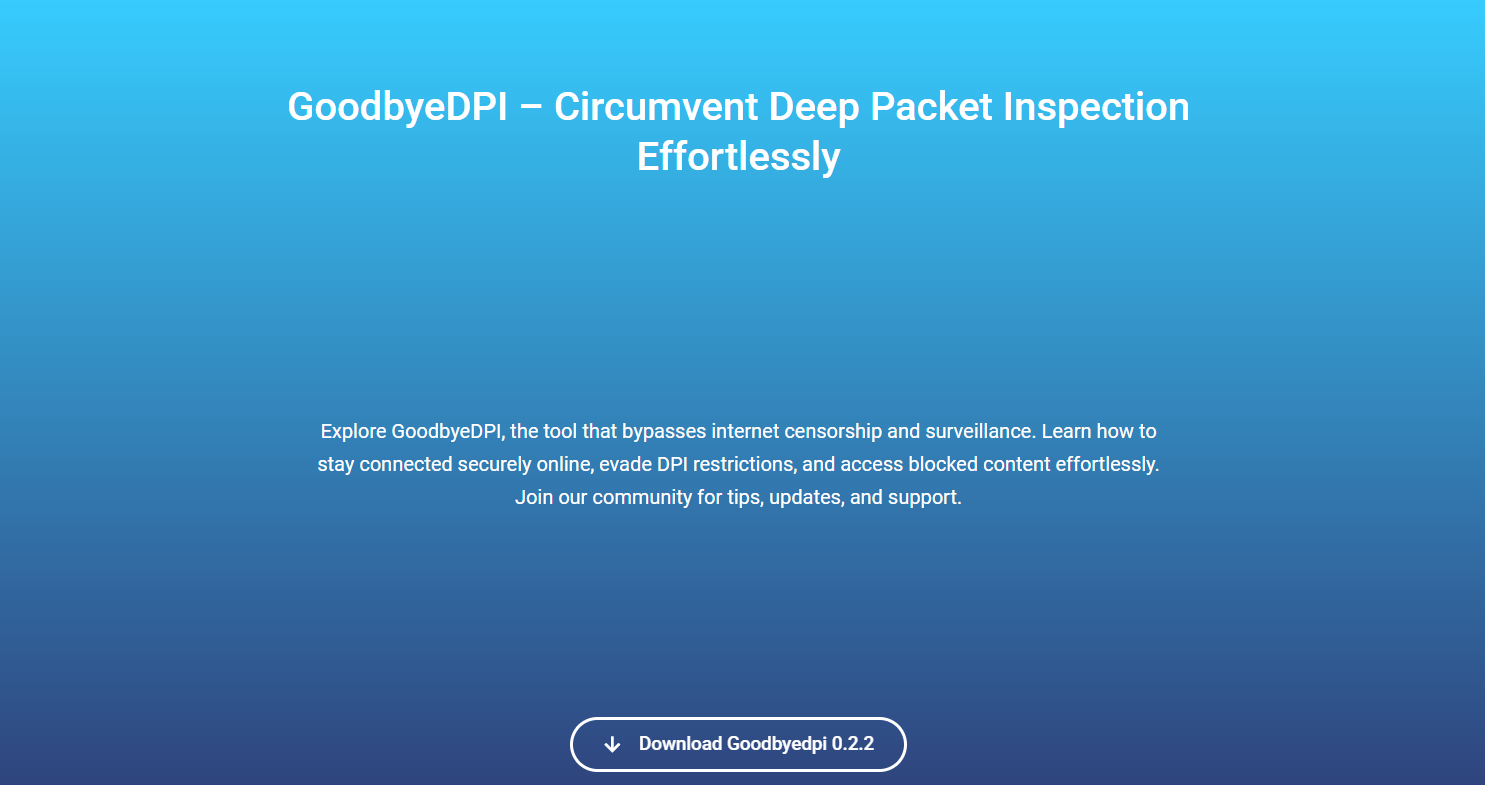What Sites Can You Access Freely Using GoodbyeDPI?

Internet censorship is a reality in many parts of the world. From blocked news platforms to restricted social media, governments and ISPs (Internet Service Providers) routinely use Deep Packet Inspection (DPI) to control what users can and cannot see. That’s where GoodbyeDPI comes in—a lightweight, open-source tool explicitly built to bypass DPI techniques and restore open access to the web.
This article dives into how GoodbyeDPI works, the types of websites it can help you access, and why it’s quickly becoming a go-to tool for users seeking freedom online.
Goodbye, DPI and Internet Censorship
Censorship takes many forms—DNS poisoning, IP blocking, keyword filtering, and the increasingly common Deep Packet Inspection (DPI). DPI scans data packets on the network level, analyzing and classifying them. This allows ISPs or governments to identify traffic to restricted sites and block it, even when you’re using HTTPS.
Goodbye, DPI doesn’t rely on VPNs or proxies. Instead, it modifies outgoing packets subtly—enough to confuse DPI systems without disrupting the target website. This approach helps users circumvent restrictions without alerting surveillance systems that typically monitor VPN or proxy usage.
How GoodbyeDPI Works Behind the Scenes
Rather than tunneling your traffic through external servers, GoodbyeDPI intercepts and alters specific fields in HTTP and HTTPS packet headers:
- It fragments the HTTP Host field
- It sends fake “Host” headers
- It disables HTTP pipelining
- It modifies TCP/IP packets to make them non-standard but still readable by target websites
These changes prevent DPI systems from identifying what website you’re accessing, allowing the request to go through without triggering censorship.
Because it doesn’t reroute your traffic, GoodbyeDPI often results in faster load times compared to VPNs, which is a huge bonus for accessing multimedia and data-heavy platforms.
Types of Websites Accessible with GoodbyeDPI
GoodbyeDPI is especially effective for sites blocked via DPI techniques rather than full IP bans or DNS hijacking. Here’s a closer look at the kinds of websites users can access with this tool.
Independent News Portals
Journalistic independence is a major target for censorship. Countries with strict media controls often block platforms such as:
- BBC
- Deutsche Welle
- Radio Free Europe
- Al Jazeera
- The Intercept
These sites are often subject to DPI-based restrictions instead of complete IP blocking. GoodbyeDPI helps users in restricted regions read uncensored news and stay informed.
Social Media Platforms
Governments sometimes block platforms temporarily during elections, protests, or periods of political instability. GoodbyeDPI enables access to:
- Twitter (X)
- TikTok
- Snapchat
Unlike VPNs that may be detected or slowed down, GoodbyeDPI operates more stealthily, maintaining smoother performance for real-time interactions.
Messaging and Communication Apps
Encrypted messaging services are another common target for DPI. Platforms like:
- Telegram
- Signal
- WhatsApp Web
- Discord
often face access issues. GoodbyeDPI helps users keep communications intact and private even under heavy surveillance.
Cryptocurrency and Blockchain Platforms
Financial freedom is another concern. Some countries block access to crypto exchanges and blockchain data explorers. With GoodbyeDPI, users can reach:
- Binance
- Coinbase
- Blockchain.com
- Etherscan
- Crypto.com
By bypassing DPI filters, individuals retain access to their wallets, transactions, and market data.
Online Communities and Forums
Discussion platforms frequently get blacklisted for hosting dissenting opinions. GoodbyeDPI helps users access:
- Quora
- 4chan
- Hacker News
- Voat (when it was active)
These platforms are crucial for open dialogue, free exchange of information, and collective learning.
Educational Resources
Certain educational platforms are mistakenly or deliberately blocked due to DPI classification errors. GoodbyeDPI restores access to:
- Coursera
- edX
- Khan Academy
- MIT OpenCourseWare
- Academic journals and research sites
Students, researchers, and lifelong learners can benefit from unrestricted access to global knowledge.
Software Development Platforms
Coding communities and repositories often contain tools that are frowned upon in censorship-heavy nations. GoodbyeDPI allows seamless access to:
- GitHub
- Stack Overflow
- Bitbucket
- GitLab
These platforms are essential for developers, startups, and open-source contributors.
Streaming Services and Multimedia Platforms
While GoodbyeDPI doesn’t spoof geo-restrictions (like Netflix content libraries), it can help bypass regional blocks on platforms such as:
- YouTube
- SoundCloud
- Twitch
- Vimeo
This is particularly helpful during nationwide blackouts or blocks targeting creators and protest-related content.
Why GoodbyeDPI Works Where VPNs Struggle
In regions with aggressive DPI firewalls, VPNs are often detected, throttled, or blocked outright. Authorities might monitor for VPN protocols or even penalize users for using them. GoodbyeDPI sidesteps this problem by never establishing a tunneling session.
Advantages include:
- No external servers: No reliance on foreign infrastructure
- Minimal overhead: Faster performance compared to VPNs
- No installation: Runs as a standalone executable on Windows
- Open-source nature: Transparent and customizable
These attributes make GoodbyeDPI a powerful tool for anyone wanting discreet, high-speed access to blocked content.
Real-World Examples of GoodbyeDPI in Action
Russia’s Internet Restrictions
Russia is known for using DPI to block sites such as LinkedIn, Telegram, and certain foreign news agencies. GoodbyeDPI became a popular workaround during major protest periods, especially when platforms like Twitter and Facebook were throttled.
Iran’s Messaging Blocks
During protests or politically sensitive events, Iran often restricts apps like Signal and WhatsApp. GoodbyeDPI has been adopted by tech-savvy citizens to keep communication open, especially when mobile VPNs fail.
China’s Great Firewall
While China’s firewall is among the most advanced, some users report that GoodbyeDPI can still bypass lower-level filtering mechanisms in certain cases, particularly on less monitored ISPs or academic networks.
Setup and Usage Simplicity
Running GoodbyeDPI is surprisingly easy:
- Download the latest version from the official GitHub repository.
- Leave the window open or configure it to run as a service in the background.
- Use your browser or any application as normal—no further configuration required.
GoodbyeDPI works well in combination with DNS-over-HTTPS (DoH) tools or custom resolvers to mitigate DNS-level censorship.
Limitations and Considerations
While powerful, GoodbyeDPI isn’t a silver bullet. Some key points to keep in mind:
- Ineffective against full IP bans: If a site is entirely blocked at the IP level, GoodbyeDPI won’t help.
- Windows-only tool: Currently designed only for Windows operating systems.
- No encryption layer: It doesn’t protect your traffic from surveillance—pair with Tor or DoH for more privacy.
- May require admin access: Setup typically needs administrator privileges.
For higher-risk users, combining GoodbyeDPI with other privacy tools (like Tor Browser or Encrypted DNS) offers better protection and flexibility.
Legal and Ethical Implications
Using censorship bypass tools carries legal risk depending on your jurisdiction. In some countries, using tools like GoodbyeDPI may violate local regulations. Users should:
- Understand the laws in their country
- Avoid bypassing restrictions at work or public institutions without permission
- Use the tool ethically—not for accessing harmful or illegal content
That said, accessing the free web for information, communication, or education remains a fundamental right in most democratic societies.
Conclusion
GoodbyeDPI isn’t just another proxy tool—it’s a smart, surgical strike against DPI-based censorship. Whether you’re trying to read the news, message a friend, or access your favorite dev forum, GoodbyeDPI provides a fast and simple solution to keep your web open.
By bypassing restrictive filters without sacrificing speed, it empowers users to explore, learn, and connect in regions where information freedom is under threat.



